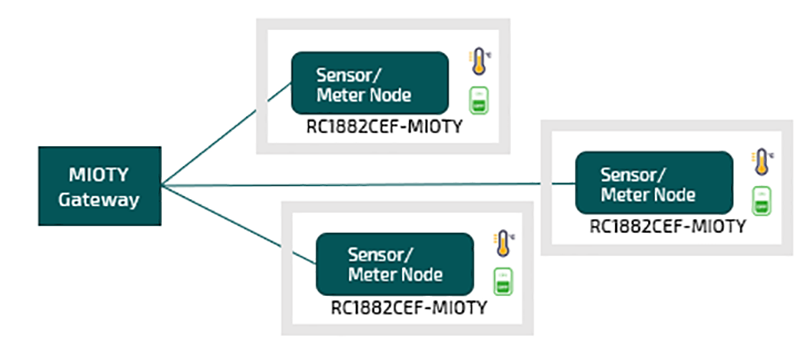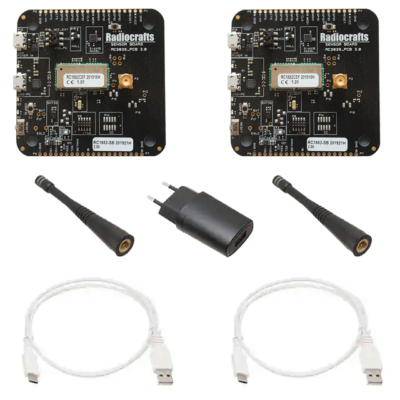The MIOTY Parts and Tools
The MIOTY parts and tools describe the different HW parts you need to build your MIOTY Network and the tools needed to support the project development with fast to market requirements.
Radiocrafts’ goal has always been to make our products easy to use and the documentation easy to follow. This is no different with the Mioty parts and tools!
Please click here to see a full overview of the MIOTY technology.
The MIOTY Parts
The MIOTY Network is built using the following HW parts:

The MIOTY Modules
The MIOTY module comes in two different hardware options:
- RC1882CEF-MIOTY1
- RC1882CEF-MIOTY2 (to be released)
The RC1882CEF-MIOTY1 module is a compact surface-mounted, high performance radio module that contains a communication controller with embedded Mioty protocol software and is pre-certified for operation under European (868 MHz) and US (915 MHz) regulations. It supports a UART interface and is based on an AT command set. The module is shielded and measures only 12.7 x 25.4 x 3.7 mm, pin compatible with legacy modules for easy integration.
The RC1882CEF-MIOTY2 module is a compact surface-mounted, high performance, autonomous radio module with the full Mioty protocol stack and application layer embedded in the module. It is pre-certified for operation under European (868 MHz) and US (915 MHz) regulations. The module is customizable/programmable in just 100 lines of high-level C-code via Radiocrafts’ innovative and unique ICI framework, using an API to tailor the modules’ behavior to the customers’ unique requirements. In its simplest form, the user uses ICI to configure the radio network, the modules’ hardware interfaces, and defines when to read and write to those interfaces. A Software Development Kit is available for application development. The module is shielded and measures only 12.7 x 25.4 x 3.7 mm, pin compatible with legacy modules for easy integration.

The MIOTY stack has the best-in-class reliability, scalability, and noise immunity of all LPWANs existing today, and an impressive range of 20 kilometres Line-of-Sight due to the unique telegram splitting technology (ETSI TS 103 357).
The MIOTY modules have the lowest cost of ownership and are easy-to-use, require low R&D investment, are fully RF tested during production, with proven quality and a fast to market experience.
They are based on an ultra-narrowband state-of-the-art radio with an output power of 14 dBm and a sensitivity of -129 dBm. The modules support ultra-low power modes for battery operated systems.
Radiocrafts also offers customization and design services for sensor integration, antenna design, battery and power management design, PCB design, end product certification, and more.
The MIOTY Gateway
IMPORTANT: You will need a MIOTY gateway to set up a complete system. Such a gateway can be purchased from a 3rd party.
The MIOTY Tools
The MIOTY Tools are developed to support a project with fast to market requirements. We strive to make the tools easy to use and make the documentation easy to follow.
The BootLoader Utility (to be released)
The “BootLoader Utility” is a software tool which will be available for customers using the RC1882CEF-MIOTY1 module.
It is used to set the network encryption key and to make firmware upgrades in case debugging is necessary or if Radiocrafts adds new features to the module.
The MIOTY SDK (to be released)
The MIOTY SDK supports development of code for the ICI application in the RC1882CEF-MIOTY2 module.
A custom ICI application for wireless sensors or actuators can be quickly and easily developed on the RC1882CEF-MIOTY2 Module. An ICI application is always running on the module on top of the Platform Image, to tailor the modules behaviour to the customers unique requirements. The ICI application is written in a high-level C-language, using a powerful API that is available in the SDK.
The API removes the need for the developer to understand the underlying architecture and resources in the module. An ICI application can typically be done with less than 100 lines of code and within a few hours.
No expertise in wireless networking or device specific knowledge is required.
The MIOTY SDK comes with:
- Extensive documentation
- Platform firmware for the RC1882CEF-MIOTY2 module in encrypted binary
- C Libraries
- Build scripts
- Flashing tools
The MIOTY Development Kit
The Development Kits include all hardware needed to run a small MIOTY network from a PC. This allows the customer to test the network capabilities with minimum development resources needed. This is ideal for a first range test in a customer environment.
We recommend that you buy a MIOTY Development Kit in your early stage product evaluation. The Development Kits are designed to be easy to use and to very quickly support a wireless link or network, where you can make a good analysis of the network performance.
The RC1882-MIOTY1-DK includes:
- 2 Development Boards with RC1882CEF-MIOTY1 modules
- Breakout of all I/O pins for easy prototyping
- 2 antennas
- FDTI chip for USB to UART interface
- 2 USB cables
The RC1882-MIOTY2-DK includes (to be released):
- 2 Sensor Boards with RC1882CEF-MIOTY2 modules, and 7 industry-standard sensors:
- 2 temperature and humidity sensors
- Analog light sensor
- Hall detector
- Accelerometer
- LED, controlled by the GPIO
- VOC gas sensor (Air quality sensor)
- Breakout of all I/O pins for easy prototyping
- FDTI chip for USB to UART interface
- 2 USB cables
- 2 antennas

The BootLoader Utility is available for the RC1882CEF-MIOTY1 and is intended to be used with the RC1882-MIOTY1-DK Development Kit, providing a complete prototyping solution where network characteristics can be tested.
The Mioty SDK is available for application development on the RC1882CEF-MIOTY2 module and is intended to be used with the RC1882CEF-MIOTY2-DK Development Kit, providing a complete prototyping solution where network characteristics can be tested, and the configuration parameters can be selected.

Note: The use of this module in an end-product is subject to an IPR license fee (see Sisvel.com).
Please click here to see a full overview of the MIOTY technology.
